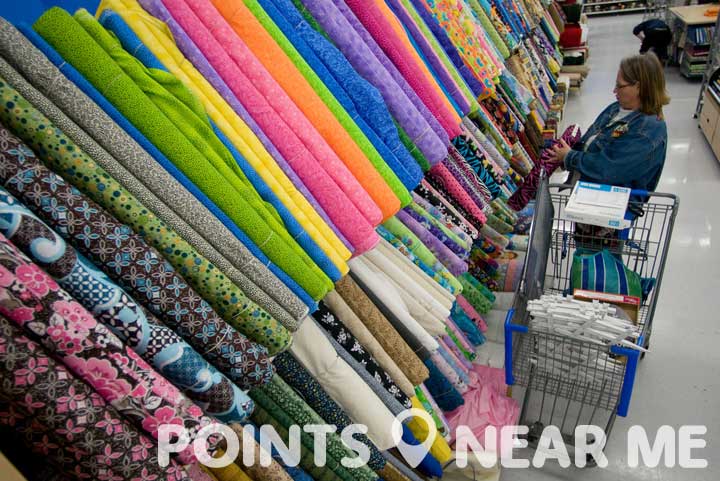Fabric Stores Near Me
When it comes to fabric, the history is as vast and varied as the item itself. In many ways, fabric has always been an essential human need. From crafting clothing and blankets, to textiles for window coverings and even diapers, fabric has a wide variety of uses that far exceed the confines of the imagination.
Are you interested in finding fabric stores in your area? You’ve come to the right place. Simply browse fabric stores near me on the map below and find a list of fabric stores in a close proximity to your current location. Need a bit more information on fabric and fabric stores? Read on for facts, trivia, and history on this essential everyday item.
Fabric Stores Near Me – Find it on the Map
Fabric Stores Near Me – Fabric Stores Trivia
When did fabrics first debut in history?
It’s difficult to imagine modern life without fabrics, but up until the stone age humans existed without this seemingly essential everyday item. According to historians, fabrics first appeared in the Middle East during the stone age. There is evidence that supports humans sporting clothes as far back as 500,000 years ago. Although it is widely believed that most clothing consisted of skins, furs, and reeds: these items are still considered early forms of fabric to many involved in the history. The earliest sewing needle dates back to France in around 19,000 BC, but archaeological studies have also found needles that reportedly date back to an astounding 40,000 years ago. This is when dyed flax fibers first appeared in what is now known as Georgia. These fabrics likely debuted around 36,000 years ago. Evidence shows that humans were weaving in the Czech Republic as far as 27,000 years ago in the form of impressions of textiles, baskets, and even nets on clay. Consider these facts while searching fabric stores near me!

Fabric stores offer rows and rows of interesting textiles to choose from!
What is the basis of any fabric?
If you’re searching fabric stores near me, you may be wondering what the basis of any fabric really is. Of course, the basis of any fabric is of course, the textile. Textiles consist of either felt or spun fibers which are then made into yarn. Yarn can be woven, knitted, laced, netted, and potentially interlaced or felted to form fabrics. The nature of all fabrics is largely dependent upon the types of dye and the type of textiles that were available to the culture at hand. There was a time when only naturally occurring fibers were available, thus making choice limited to wool, cotton, silk, and flax. Animal textiles are still the most common textiles in our society. Examples of animal textiles include silk, pashmina, and wool. These textiles are still widely used and beloved today. Plain textiles (which are also quite common) include cotton, straw, grass, rubber, and bamboo. There are also mineral textiles which are made from glass fibers, asbestos, and even metal fibers.
Fabric Stores Near Me – Fabric Stores Facts
Synthetic Fibers
While searching fabric stores near me, you may be wondering when synthetic fibers first appeared. After all, synthetic fibers are pretty common in many clothing stores and textiles. Believe it or not, synthetic fibers only arrived on the scene about one century ago. It is believed that synthetic fibers were invented to combat the age old problems of wrinkling and lack of elasticity in clothing. Attempts at making synthetic fibers were believed to have been done 200 years prior, but the synthesized petroleum compounds and chemical processes necessary for creating synthetic fibers only reached that level around one century ago. Even Nylon wasn’t invented until 1939!
Fabric Manufacture
Fabrics are manufactured in many ways, but the oldest form of fabric manufacture has always been felting. Felting is squeezing a mat of fibers together in a liquid in order to achieve a flat, tangled and finished material. Though felting was successful, knitting soon hit the scene and gained massive popularity. Knitting is the interlacing of yarn using a needle. After knitting, the next logical step forward was weaving. Weaving was done on a complex loom or rectangular frame where strands of yarn were hung and then interlaced. Today there are three basic steps required for fabric production. The first step is creating the yarns. Once the raw materials were harvested they are processed and transformed from raw fibers into yarn and threads. This is done by spinning the fibers. While the spinning can be done by hand (and previously was), the process is tedious and time consuming. Nowadays, a vast majority of spinning is done on a spinning wheel. The fibers are drawn across the wheel and as it spins, the fibers are collected on a an object known as a bobbin. In the second step, bobbins are transferred to a new machine where it is to be woven. The final step is processing. In processing, the fabric is removed from the weaving loom where and prepped to be dyed. Fabric fresh off the loom is called greige and looks nothing like the clothing or sheets that you’re currently used to. While searching fabric stores near me, consider just how intricate the process of creating fabric truly is!












